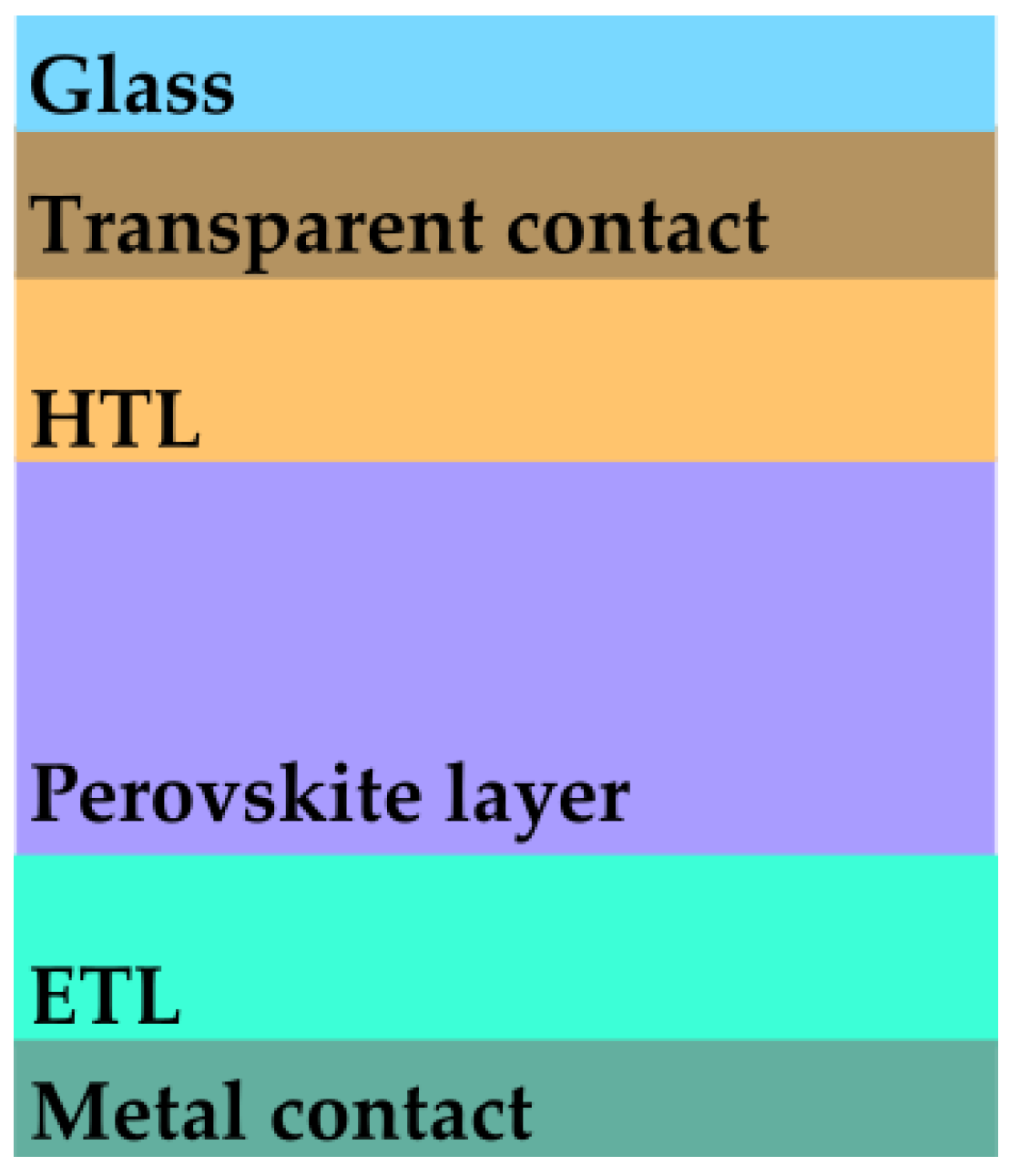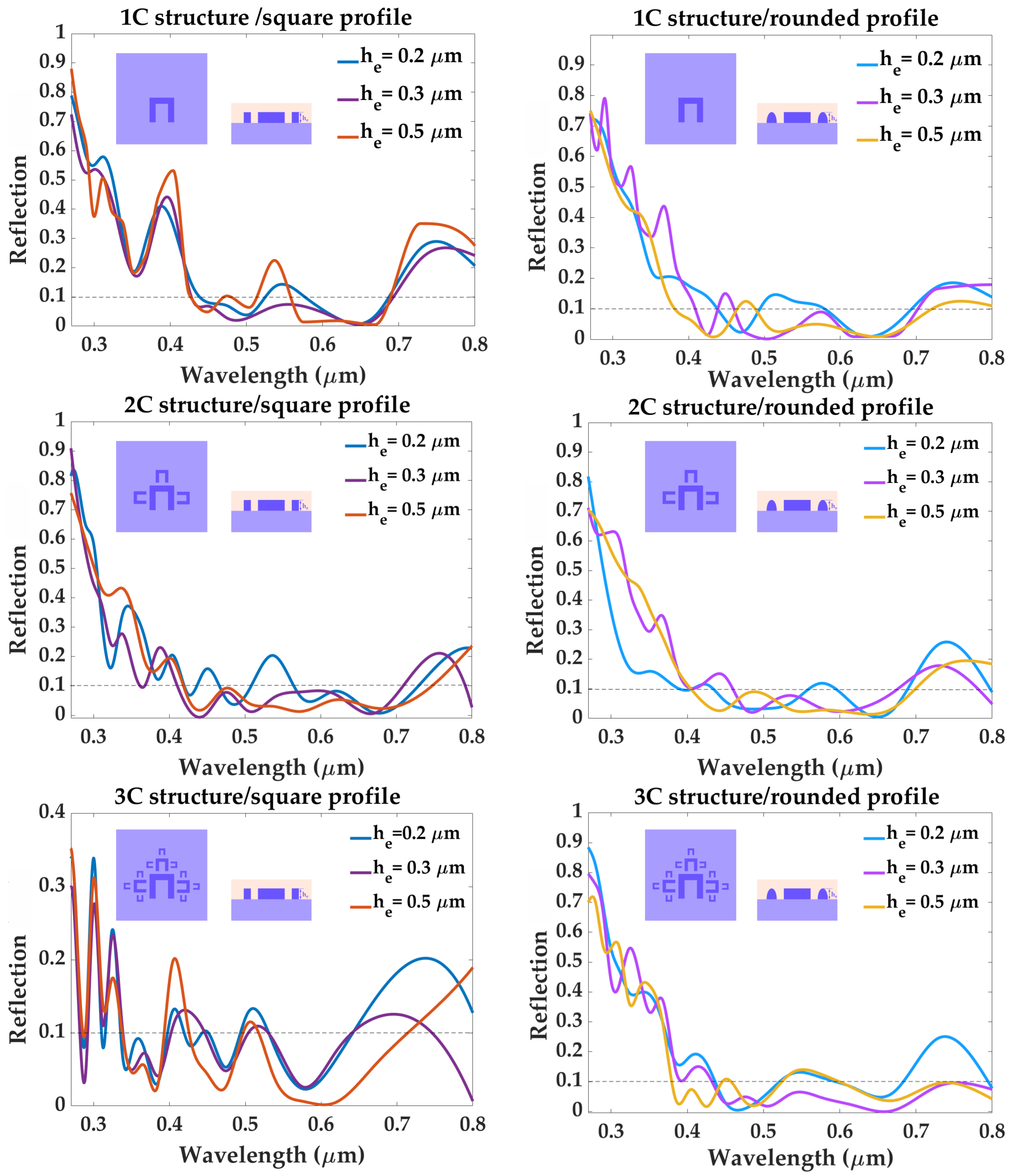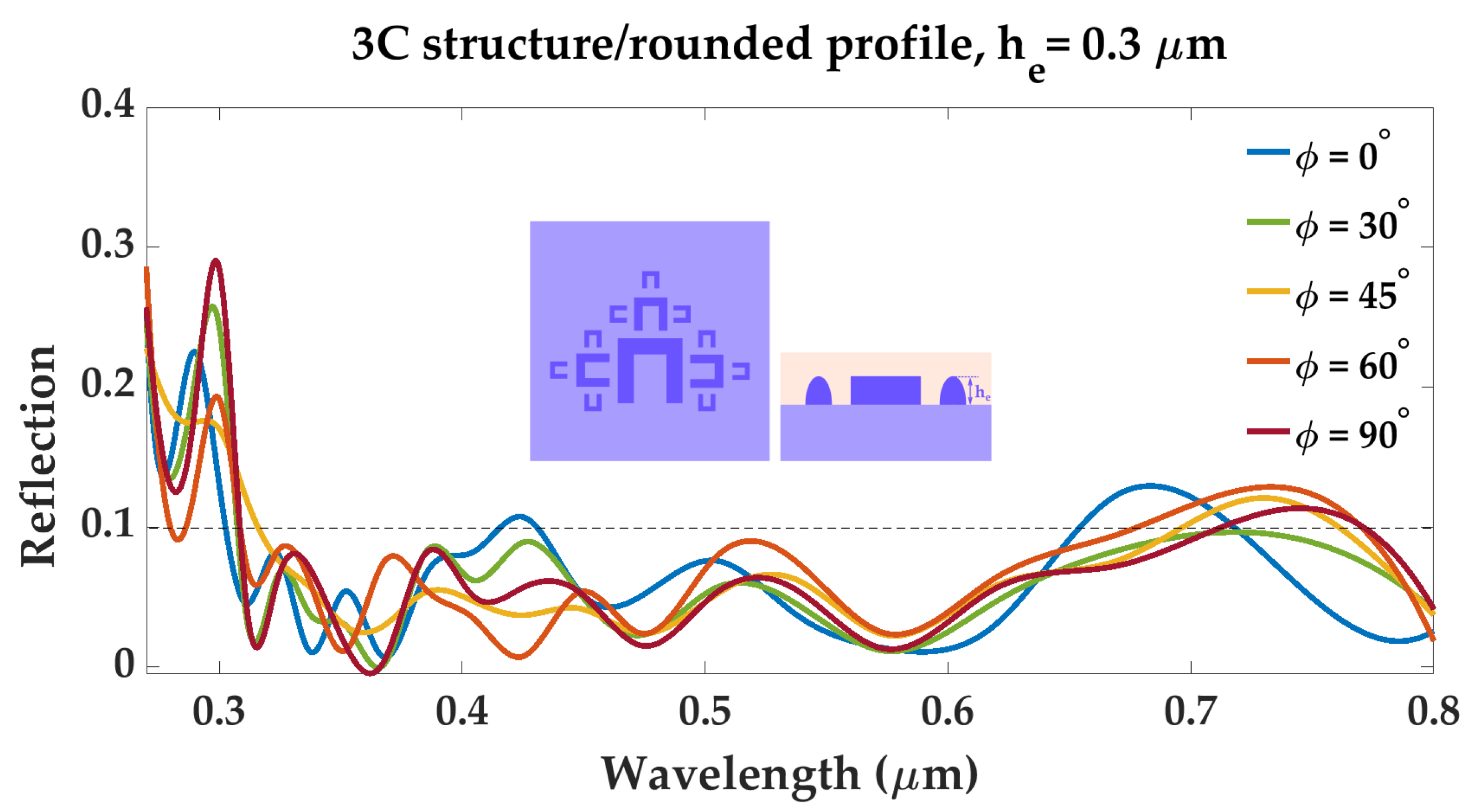Towards High-Efficiency Photon Trapping in Thin-Film Perovskite Solar Cells Using Etched Fractal Metadevices
Abstract
1. Introduction
2. Design Considerations and Simulation Conditions
3. Results and Discussion
4. Conclusions
Author Contributions
Funding
Institutional Review Board Statement
Informed Consent Statement
Data Availability Statement
Conflicts of Interest
References
- Wang, Z.; Zeng, L.; Zhu, T.; Chen, H.; Chen, B.; Kubicki, D.J.; Balvanz, A.; Li, C.; Maxwell, A.; Ugur, E.; et al. Suppressed phase segregation for triple-junction perovskite solar cells. Nature 2023, 1–3. [Google Scholar] [CrossRef] [PubMed]
- Ren, W.; Li, S.; Ren, J.; Liu, Y.; Wu, Y.; Sun, Q.; Cui, Y.; Hao, Y. Cyano-4-Pentylbiphenyl dopant strategy for P3HT-Based CsPbI3 perovskite solar cells with a record efficiency and preeminent stability. Chem. Eng. J. 2023, 455, 140831. [Google Scholar] [CrossRef]
- Isikgor, F.H.; Zhumagali, S.; T. Merino, L.V.; De Bastiani, M.; McCulloch, I.; De Wolf, S. Molecular engineering of contact interfaces for high-performance perovskite solar cells. Nat. Rev. Mater. 2023, 8, 89–108. [Google Scholar] [CrossRef]
- Yang, L.; Feng, J.; Liu, Z.; Duan, Y.; Zhan, S.; Yang, S.; He, K.; Li, Y.; Zhou, Y.; Yuan, N.; et al. Record-efficiency flexible perovskite solar cells enabled by multifunctional organic ions interface passivation. Adv. Mater. 2022, 34, 2201681. [Google Scholar] [CrossRef]
- Jiang, X.; Zang, Z.; Zhou, Y.; Li, H.; Wei, Q.; Ning, Z. Tin halide perovskite solar cells: An emerging thin-film photovoltaic technology. Accounts Mater. Res. 2021, 2, 210–219. [Google Scholar] [CrossRef]
- Peng, Y.; Huang, J.; Zhou, L.; Mu, Y.; Han, S.; Zhou, S.; Gao, P. Efficient thin-film perovskite solar cells from a two-step sintering of nanocrystals. Nanoscale 2023, 15, 2924–2931. [Google Scholar] [CrossRef]
- Finkenauer, B.P.; Zhang, Y.; Ma, K.; Turnley, J.W.; Schulz, J.; Gómez, M.; Coffey, A.H.; Sun, D.; Sun, J.; Agrawal, R.; et al. Amine-Thiol/Selenol Chemistry for Efficient and Stable Perovskite Solar Cells. J. Phys. Chem. C 2023, 127, 930–938. [Google Scholar] [CrossRef]
- Yerezhep, D.; Omarova, Z.; Aldiyarov, A.; Shinbayeva, A.; Tokmoldin, N. IR Spectroscopic Degradation Study of Thin Organometal Halide Perovskite Films. Molecules 2023, 28, 1288. [Google Scholar] [CrossRef]
- Naqvi, F.H.; Ko, J.H. Structural Phase Transitions and Thermal Degradation Process of MAPbCl3 Single Crystals Studied by Raman and Brillouin Scattering. Materials 2022, 15, 8151. [Google Scholar] [CrossRef]
- Omarova, Z.; Yerezhep, D.; Aldiyarov, A.; Tokmoldin, N. In Silico Investigation of the Impact of Hole-Transport Layers on the Performance of CH3NH3SnI3 Perovskite Photovoltaic Cells. Crystals 2022, 12, 699. [Google Scholar] [CrossRef]
- Wali, Q.; Iftikhar, F.J.; Khan, M.E.; Ullah, A.; Iqbal, Y.; Jose, R. Advances in stability of perovskite solar cells. Org. Electron. 2020, 78, 105590. [Google Scholar] [CrossRef]
- Wu, F.; Pathak, R.; Chen, K.; Wang, G.; Bahrami, B.; Zhang, W.H.; Qiao, Q. Inverted current–voltage hysteresis in perovskite solar cells. ACS Energy Lett. 2018, 3, 2457–2460. [Google Scholar] [CrossRef]
- Kang, D.H.; Park, N.G. On the current–voltage hysteresis in perovskite solar cells: Dependence on perovskite composition and methods to remove hysteresis. Adv. Mater. 2019, 31, 1805214. [Google Scholar] [CrossRef]
- Conings, B.; Drijkoningen, J.; Gauquelin, N.; Babayigit, A.; D’Haen, J.; D’Olieslaeger, L.; Ethirajan, A.; Verbeeck, J.; Manca, J.; Mosconi, E.; et al. Intrinsic thermal instability of methylammonium lead trihalide perovskite. Adv. Energy Mater. 2015, 5, 1500477. [Google Scholar] [CrossRef]
- Zhao, X.; Park, N.G. Stability issues on perovskite solar cells. Photonics 2015, 2, 1139–1151. [Google Scholar] [CrossRef]
- Singh, R.; Parashar, M. Origin of Hysteresis in Perovskite Solar Cells. In Soft-Matter Thin Film Solar Cells: Physical Processes and Device Simulation; AIP Publishing LLC: Melville, NY, USA, 2020. [Google Scholar]
- Aydin, E.; De Bastiani, M.; De Wolf, S. Defect and contact passivation for perovskite solar cells. Adv. Mater. 2019, 31, 1900428. [Google Scholar] [CrossRef]
- Almora, O.; Lopez-Varo, P.; Cho, K.T.; Aghazada, S.; Meng, W.; Hou, Y.; Echeverría-Arrondo, C.; Zimmermann, I.; Matt, G.J.; Jiménez-Tejada, J.A.; et al. Ionic dipolar switching hinders charge collection in perovskite solar cells with normal and inverted hysteresis. Sol. Energy Mater. Sol. Cells 2019, 195, 291–298. [Google Scholar] [CrossRef]
- Hu, X.; Wang, H.; Wang, M.; Zang, Z. Interfacial defects passivation using fullerene-polymer mixing layer for planar-structure perovskite solar cells with negligible hysteresis. Sol. Energy 2020, 206, 816–825. [Google Scholar] [CrossRef]
- Kan, C.; Tang, Z.; Yao, Y.; Hang, P.; Li, B.; Wang, Y.; Sun, X.; Lei, M.; Yang, D.; Yu, X. Mitigating ion migration by polyethylene glycol-modified fullerene for perovskite solar cells with enhanced stability. ACS Energy Lett. 2021, 6, 3864–3872. [Google Scholar] [CrossRef]
- Yang, J.; Tang, W.; Yuan, R.; Chen, Y.; Wang, J.; Wu, Y.; Yin, W.J.; Yuan, N.; Ding, J.; Zhang, W.H. Defect mitigation using d-penicillamine for efficient methylammonium-free perovskite solar cells with high operational stability. Chem. Sci. 2021, 12, 2050–2059. [Google Scholar] [CrossRef]
- Choi, J.S.; Jang, Y.W.; Kim, U.; Choi, M.; Kang, S.M. Optically and Mechanically Engineered Anti-Reflective Film for Highly Efficient Rigid and Flexible Perovskite Solar Cells. Adv. Energy Mater. 2022, 12, 2201520. [Google Scholar] [CrossRef]
- Spence, M.; Hammond, R.; Pockett, A.; Wei, Z.; Johnson, A.; Watson, T.; Carnie, M.J. A Comparison of Different Textured and Non-Textured Anti-Reflective Coatings for Planar Monolithic Silicon-Perovskite Tandem Solar Cells. ACS Appl. Energy Mater. 2022, 5, 5974–5982. [Google Scholar] [CrossRef] [PubMed]
- Manzoor, S.; Zhengshan, J.Y.; Ali, A.; Ali, W.; Bush, K.A.; Palmstrom, A.F.; Bent, S.F.; McGehee, M.D.; Holman, Z.C. Improved light management in planar silicon and perovskite solar cells using PDMS scattering layer. Sol. Energy Mater. Sol. Cells 2017, 173, 59–65. [Google Scholar] [CrossRef]
- Qarony, W.; Hossain, M.I.; Dewan, R.; Fischer, S.; Meyer-Rochow, V.B.; Salleo, A.; Knipp, D.; Tsang, Y.H. Approaching perfect light incoupling in perovskite and silicon thin film solar cells by moth eye surface textures. Adv. Theory Simul. 2018, 1, 1800030. [Google Scholar] [CrossRef]
- Kim, M.; Kang, T.W.; Kim, S.H.; Jung, E.H.; Park, H.H.; Seo, J.; Lee, S.J. Antireflective, self-cleaning and protective film by continuous sputtering of a plasma polymer on inorganic multilayer for perovskite solar cells application. Sol. Energy Mater. Sol. Cells 2019, 191, 55–61. [Google Scholar] [CrossRef]
- Baryshnikova, K.; Gets, D.; Liashenko, T.; Pushkarev, A.; Mukhin, I.; Kivshar, Y.; Makarov, S. Broadband antireflection with halide perovskite metasurfaces. Laser Photonics Rev. 2020, 14, 2000338. [Google Scholar] [CrossRef]
- Hossain, M.I.; Yumnam, N.; Qarony, W.; Salleo, A.; Wagner, V.; Knipp, D.; Tsang, Y.H. Non-resonant metal-oxide metasurfaces for efficient perovskite solar cells. Sol. Energy 2020, 198, 570–577. [Google Scholar] [CrossRef]
- Wang, C.; Zhang, Z. Broadband optical absorption enhancement in hybrid organic–inorganic perovskite metasurfaces. AIP Adv. 2021, 11, 025107. [Google Scholar] [CrossRef]
- Jiang, W.; Chen, X. Light absorption enhancement in ultrathin perovskite solar cells using plasmonic light trapping and bionic anti-reflection coating. AIP Adv. 2022, 12, 065106. [Google Scholar] [CrossRef]
- Danila, O.; Bărar, A.; Vlădescu, M.; Mănăilă-Maximean, D. An extended k-surface framework for electromagnetic fields in artificial media. Materials 2021, 14, 7842. [Google Scholar] [CrossRef]
- Cai, W.; Shalaev, V.M. Optical Metamaterials; Springer: Berlin/Heidelberg, Germany, 2010; Volume 10. [Google Scholar]
- He, S.; Tian, R.; Wu, W.; Li, W.D.; Wang, D. Helium-ion-beam nanofabrication: Extreme processes and applications. Int. J. Extrem. Manuf. 2020, 3, 012001. [Google Scholar] [CrossRef]
- Chiappim, W.; Neto, B.B.; Shiotani, M.; Karnopp, J.; Gonçalves, L.; Chaves, J.P.; Sobrinho, A.d.S.; Leitão, J.P.; Fraga, M.; Pessoa, R. Plasma-Assisted Nanofabrication: The Potential and Challenges in Atomic Layer Deposition and Etching. Nanomaterials 2022, 12, 3497. [Google Scholar] [CrossRef]
- Wang, Z.; Wu, Y.; Qi, D.; Yu, W.; Zheng, H. Progress in the design, nanofabrication, and performance of metalenses. J. Opt. 2022, 24, 033001. [Google Scholar] [CrossRef]
- Yin, H.; Cui, J.; Wang, X.; Ren, X.; Zhang, J.; Mei, H.; Xu, K.; Mei, X. Nanofabrication mechanism of λ/20 features achieved by coupling field tip enhancement induced with nanosecond laser irradiating AFM probe tip. Appl. Surf. Sci. 2023, 607, 155065. [Google Scholar] [CrossRef]
- Wang, B.; Quan, B.; He, J.; Xie, Z.; Wang, X.; Li, J.; Kan, Q.; Zhang, Y. Wavelength de-multiplexing metasurface hologram. Sci. Rep. 2016, 6, 35657. [Google Scholar] [CrossRef]
- Venkatesh, S.; Lu, X.; Saeidi, H.; Sengupta, K. A high-speed programmable and scalable terahertz holographic metasurface based on tiled CMOS chips. Nat. Electron. 2020, 3, 785–793. [Google Scholar] [CrossRef]
- Danila, O. Polyvinylidene Fluoride-Based Metasurface for High-Quality Active Switching and Spectrum Shaping in the Terahertz G-Band. Polymers 2021, 13, 1860. [Google Scholar] [CrossRef]
- Bărar, A.; Danila, O. Spectral Response and Wavefront Control of a C-Shaped Fractal Cadmium Telluride/Silicon Carbide Metasurface in the THz Bandgap. Materials 2022, 15, 5944. [Google Scholar] [CrossRef]
- Wang, L.; Zhang, Y.; Guo, X.; Chen, T.; Liang, H.; Hao, X.; Hou, X.; Kou, W.; Zhao, Y.; Zhou, T.; et al. A review of THz modulators with dynamic tunable metasurfaces. Nanomaterials 2019, 9, 965. [Google Scholar] [CrossRef]
- Ali, A.; Khalily, M.; Serghiou, D.; Tafazolli, R. Reflective Metasurface with Steered OAM Beams for THz Communications. IEEE Access 2023, 11, 12394–12401. [Google Scholar] [CrossRef]
- Danila, O.; Mănăilă-Maximean, D.; Bărar, A.; Loiko, V.A. Non-layered gold-silicon and all-silicon frequency-selective metasurfaces for potential mid-infrared sensing applications. Sensors 2021, 21, 5600. [Google Scholar] [CrossRef] [PubMed]
- Danila, O.; Gross, B.M. Towards Highly Efficient Nitrogen Dioxide Gas Sensors in Humid and Wet Environments Using Triggerable-Polymer Metasurfaces. Polymers 2023, 15, 545. [Google Scholar] [CrossRef] [PubMed]
- Avayu, O.; Eisenbach, O.; Ditcovski, R.; Ellenbogen, T. Optical metasurfaces for polarization-controlled beam shaping. Opt. Lett. 2014, 39, 3892–3895. [Google Scholar] [CrossRef] [PubMed]
- Scheuer, J. Metasurfaces-based holography and beam shaping: Engineering the phase profile of light. Nanophotonics 2017, 6, 137–152. [Google Scholar] [CrossRef]
- Holsteen, A.L.; Cihan, A.F.; Brongersma, M.L. Temporal color mixing and dynamic beam shaping with silicon metasurfaces. Science 2019, 365, 257–260. [Google Scholar] [CrossRef]
- Luo, X. Multiscale Optical Field Manipulation via Planar Digital Optics. ACS Photonics 2023. [Google Scholar] [CrossRef]
- Tkachenko, G.; Stellinga, D.; Ruskuc, A.; Chen, M.; Dholakia, K.; Krauss, T.F. Optical trapping with planar silicon metalenses. Opt. Lett. 2018, 43, 3224–3227. [Google Scholar] [CrossRef]
- Yang, J.; Ghimire, I.; Wu, P.C.; Gurung, S.; Arndt, C.; Tsai, D.P.; Lee, H.W.H. Photonic crystal fiber metalens. Nanophotonics 2019, 8, 443–449. [Google Scholar] [CrossRef]
- Arbabi, A.; Faraon, A. Advances in optical metalenses. Nat. Photonics 2022, 17, 16–25. [Google Scholar] [CrossRef]
- Zhang, L.; Wang, C.; Wei, Y.; Lin, Y.; Han, Y.; Deng, Y. High-Efficiency Achromatic Metalens Topologically Optimized in the Visible. Nanomaterials 2023, 13, 890. [Google Scholar] [CrossRef]
- Shameli, M.A.; Salami, P.; Yousefi, L. Light trapping in thin film solar cells using a polarization independent phase gradient metasurface. J. Opt. 2018, 20, 125004. [Google Scholar] [CrossRef]
- Voroshilov, P.M.; Ovchinnikov, V.; Papadimitratos, A.; Zakhidov, A.A.; Simovski, C.R. Light trapping enhancement by silver nanoantennas in organic solar cells. ACS Photonics 2018, 5, 1767–1772. [Google Scholar] [CrossRef]
- Lu, H.; Guo, X.; Zhang, J.; Zhang, X.; Li, S.; Yang, C. Asymmetric metasurface structures for light absorption enhancement in thin film silicon solar cell. J. Opt. 2019, 21, 045901. [Google Scholar] [CrossRef]
- Shameli, M.A.; Fallah, A.; Yousefi, L. Developing an optimized metasurface for light trapping in thin-film solar cells using a deep neural network and a genetic algorithm. JOSA B 2021, 38, 2728–2735. [Google Scholar] [CrossRef]
- Wang, R.; Yue, S.; Zhang, Z.; Hou, Y.; Zhao, H.; Qu, S.; Li, M.; Zhang, Z. Broadband perfect absorber in the visible range based on metasurface composite structures. Materials 2022, 15, 2612. [Google Scholar] [CrossRef]
- Liang, Y.; Lin, H.; Koshelev, K.; Zhang, F.; Yang, Y.; Wu, J.; Kivshar, Y.; Jia, B. Full-stokes polarization perfect absorption with diatomic metasurfaces. Nano Lett. 2021, 21, 1090–1095. [Google Scholar] [CrossRef]
- Chen, S.; Chen, Z.; Liu, J.; Cheng, J.; Zhou, Y.; Xiao, L.; Chen, K. Ultra-narrow band mid-infrared perfect absorber based on hybrid dielectric metasurface. Nanomaterials 2019, 9, 1350. [Google Scholar] [CrossRef]
- Liang, Y.; Zhang, F.; Huang, X.G.; Zheng, H. Polarization-controlled triple-band absorption in all-metal nanostructures with magnetic dipoles and anapole responses. Appl. Phys. Express 2019, 12, 062014. [Google Scholar] [CrossRef]
- Cheng, Y.; Li, Z.; Cheng, Z. Terahertz perfect absorber based on InSb metasurface for both temperature and refractive index sensing. Opt. Mater. 2021, 117, 111129. [Google Scholar] [CrossRef]
- Janneh, M.; De Marcellis, A.; Palange, E.; Tenggara, A.; Byun, D. Design of a metasurface-based dual-band Terahertz perfect absorber with very high Q-factors for sensing applications. Opt. Commun. 2018, 416, 152–159. [Google Scholar] [CrossRef]
- Niharika, N.; Singh, S. Highly sensitive tunable terahertz absorber for biosensing applications. Optik 2023, 273, 170476. [Google Scholar] [CrossRef]
- Loh, J.Y.; Safari, M.; Mao, C.; Viasus, C.J.; Eleftheriades, G.V.; Ozin, G.A.; Kherani, N.P. Near-perfect absorbing copper metamaterial for solar fuel generation. Nano Lett. 2021, 21, 9124–9130. [Google Scholar] [CrossRef] [PubMed]
- Qiu, Y.; Zhang, P.; Li, Q.; Zhang, Y.; Li, W. A perfect selective metamaterial absorber for high-temperature solar energy harvesting. Sol. Energy 2021, 230, 1165–1174. [Google Scholar] [CrossRef]
- Liu, Z.; Liu, G.; Huang, Z.; Liu, X.; Fu, G. Ultra-broadband perfect solar absorber by an ultra-thin refractory titanium nitride meta-surface. Sol. Energy Mater. Sol. Cells 2018, 179, 346–352. [Google Scholar] [CrossRef]
- Katrodiya, D.; Jani, C.; Sorathiya, V.; Patel, S.K. Metasurface based broadband solar absorber. Opt. Mater. 2019, 89, 34–41. [Google Scholar] [CrossRef]
- Xu, W.; Cheng, H.; Luo, X.; Cheng, Z.; Ke, C.; Zhai, X. A tunable all dielectric perfect absorber based on hybrid graphene-dielectric metasurface in the mid-infrared regime. Opt. Quantum Electron. 2023, 55, 272. [Google Scholar] [CrossRef]
- Swett, D.W. Near zero index perfect metasurface absorber using inverted conformal mapping. Sci. Rep. 2020, 10, 9731. [Google Scholar] [CrossRef]
- Patel, S.K.; Parmar, J.; Sorathiya, V.; Zakaria, R.B.; Nguyen, T.K.; Dhasarathan, V. Graphene-based plasmonic absorber for biosensing applications using gold split ring resonator metasurfaces. J. Lightwave Technol. 2021, 39, 5617–5624. [Google Scholar] [CrossRef]
- Niharika, N.; Singh, S.; Kumar, P. Bicontrollable all dielectric metasurface absorber for chemical and biosensing applications. Photonics Nanostruct.-Fundam. Appl. 2023, 54, 101116. [Google Scholar] [CrossRef]
- Bilal, R.; Baqir, M.; Choudhury, P.; Naveed, M.; Ali, M.; Rahim, A. Ultrathin broadband metasurface-based absorber comprised of tungsten nanowires. Results Phys. 2020, 19, 103471. [Google Scholar] [CrossRef]
- Li, Y.; Li, C.; Yu, H.; Yuan, B.; Xu, F.; Wei, H.; Cao, B. Highly conductive P-type MAPbI3 films and crystals via sodium doping. Front. Chem. 2020, 8, 754. [Google Scholar] [CrossRef]
- Leguy, A.M.; Hu, Y.; Campoy-Quiles, M.; Alonso, M.I.; Weber, O.J.; Azarhoosh, P.; Van Schilfgaarde, M.; Weller, M.T.; Bein, T.; Nelson, J.; et al. Reversible hydration of CH3NH3PbI3 in films, single crystals, and solar cells. Chem. Mater. 2015, 27, 3397–3407. [Google Scholar] [CrossRef]
- Tabor, D.P.; Chiykowski, V.A.; Friederich, P.; Cao, Y.; Dvorak, D.J.; Berlinguette, C.P.; Aspuru-Guzik, A. Design rules for high mobility xanthene-based hole transport materials. Chem. Sci. 2019, 10, 8360–8366. [Google Scholar] [CrossRef]
- Li, G.; Wang, Y.; Huang, L.; Zeng, R.; Sun, W. Inhibited Aggregation of Lithium Salt in Spiro-OMeTAD for Perovskite Solar Cells. Crystals 2022, 12, 290. [Google Scholar] [CrossRef]
- Filipič, M.; Löper, P.; Niesen, B.; De Wolf, S.; Krč, J.; Ballif, C.; Topič, M. CH 3 NH 3 PbI 3 perovskite/silicon tandem solar cells: Characterization based optical simulations. Opt. Express 2015, 23, A263–A278. [Google Scholar] [CrossRef]






| Element | Notation | Size |
|---|---|---|
| Main “C” element length | ||
| Main “C” element width | ||
| Medium “C” element length | ||
| Medium “C” element width | ||
| Small “C” element length | ||
| Small “C” element width | ||
| Substrate height | 2 | |
| “C” elements height | ||
| Coating layer height | 2 | |
| Gap between “C” elements | g | |
| Cell size | P | 2 |
Disclaimer/Publisher’s Note: The statements, opinions and data contained in all publications are solely those of the individual author(s) and contributor(s) and not of MDPI and/or the editor(s). MDPI and/or the editor(s) disclaim responsibility for any injury to people or property resulting from any ideas, methods, instructions or products referred to in the content. |
© 2023 by the authors. Licensee MDPI, Basel, Switzerland. This article is an open access article distributed under the terms and conditions of the Creative Commons Attribution (CC BY) license (https://creativecommons.org/licenses/by/4.0/).
Share and Cite
Bărar, A.; Maclean, S.A.; Dănilă, O.; Taylor, A.D. Towards High-Efficiency Photon Trapping in Thin-Film Perovskite Solar Cells Using Etched Fractal Metadevices. Materials 2023, 16, 3934. https://doi.org/10.3390/ma16113934
Bărar A, Maclean SA, Dănilă O, Taylor AD. Towards High-Efficiency Photon Trapping in Thin-Film Perovskite Solar Cells Using Etched Fractal Metadevices. Materials. 2023; 16(11):3934. https://doi.org/10.3390/ma16113934
Chicago/Turabian StyleBărar, Ana, Stephen Akwei Maclean, Octavian Dănilă, and André D. Taylor. 2023. "Towards High-Efficiency Photon Trapping in Thin-Film Perovskite Solar Cells Using Etched Fractal Metadevices" Materials 16, no. 11: 3934. https://doi.org/10.3390/ma16113934
APA StyleBărar, A., Maclean, S. A., Dănilă, O., & Taylor, A. D. (2023). Towards High-Efficiency Photon Trapping in Thin-Film Perovskite Solar Cells Using Etched Fractal Metadevices. Materials, 16(11), 3934. https://doi.org/10.3390/ma16113934






